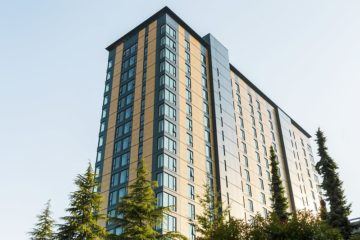Klaus Sieg in Reasons to be Cheerful:
 At Vancouver’s University of British Columbia, the Brock Commons Tallwood House, sheathed in sleek blond wood, stands out among the neighboring gray concrete towers. This striking facade isn’t just an aesthetic choice. When it opened in 2017, the 18-story residence hall was the tallest building constructed of timber in the world. Erected from prefabricated components in just 70 days, it was faster and cheaper to build than a conventional building. What’s more, its material saved over 2,400 metric tons of carbon emissions.
At Vancouver’s University of British Columbia, the Brock Commons Tallwood House, sheathed in sleek blond wood, stands out among the neighboring gray concrete towers. This striking facade isn’t just an aesthetic choice. When it opened in 2017, the 18-story residence hall was the tallest building constructed of timber in the world. Erected from prefabricated components in just 70 days, it was faster and cheaper to build than a conventional building. What’s more, its material saved over 2,400 metric tons of carbon emissions.
Brock Commons defies a century of high-rise construction norms. Since the dawn of the skyscraper age, cement, concrete and steel have molded our vertical urban realms. But the environmental consequences of these materials has led some in the construction industry back to wood, a material that’s more sustainable and, with each technological leap, an increasingly viable option for large-scale projects.
Proponents of wood construction argue that it is carbon negative, in that it effectively takes CO2 captured by trees and locks it into the buildings it supports. But wood construction has its challenges. Only in the last few years has it begun to come into its own, shepherded by a wave of government incentives, pent-up demand and technological advancements.
More here.
